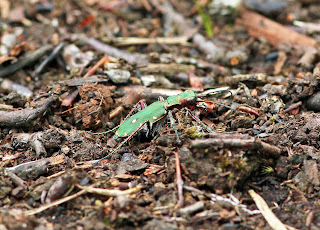I had primarily visited today to record Odonata,but as always it is a great place for all other types of wildlife and is a great day out and today was certainly no exception.
Bird wise it was superb today with one schedule 1 species in cracking breeding habitat which i unfortunately cannot mention here,but it was a personal first for the reserve and a very welcome duo of singing male Turtle Doves and a singing male Tree Pipit were also seen.A couple of flyby Siskins and a pair of Common Buzzard completed the bird highlights.
Today belonged to insects,as on most of my visits here and some superb species were encountered,with one particularly stunning addition to my insect species list.
While looking for Odonata,i flushed a couple of tiny pinkish/purple moths,with gold borders and spots on the wings and after returning home and looking them up turned out to be Purple-bordered Gold moths,a new species for myself and also a relatively rare species in the UK,being stated as nationally scarce b.What a cracking little moth!.
Other insect highlights included only my second ever Heather Bug,3 male Bog-bush Cricket and my first Large Heaths of the year along with other Crowle goodies which included the stunning Green-tiger Beetles and Sericomyia silentis.
The only mammal highlight went to a majestic stag Red Deer which watched me from fairly close range,with his new antlers growing and covered in velvet,before he disappeared into thicker undergrowth with a disgusted bark at me disturbing him.
For a change a few interesting flowers were noted today also and included the rare Greater-yellow Rattle,Common-spotted and Southern-marsh Orchids and Self Heal seemed to be growing everywhere.
Another superb visit to this brilliant reserve was enjoyed today and i journeyed home contented with what i had seen.
A quick note to visitors to the site,please note because of the abundance of deer,that deer ticks are becoming a much more commonly encountered and to please check yourself after visiting as there is a real danger from contracting Lymes disease from any bites.If you are bitten and have a bite with a mark like a bulls eye(a red spot with an outer circle),please visit your Doctor.
 |
| Heather Bug. |
 |
| Heather Bug. |
 |
| Large Heath. |
 |
| Sericomyia silentis. |
 |
| Green-tiger Beetle. |
 |
| Male Nursery-web Spider. |
 |
| Conopid Fly sp. Sicus ferrugineus. |
 |
| Purple-bordered Gold of the form 'Totarubra'. |

No comments:
Post a Comment